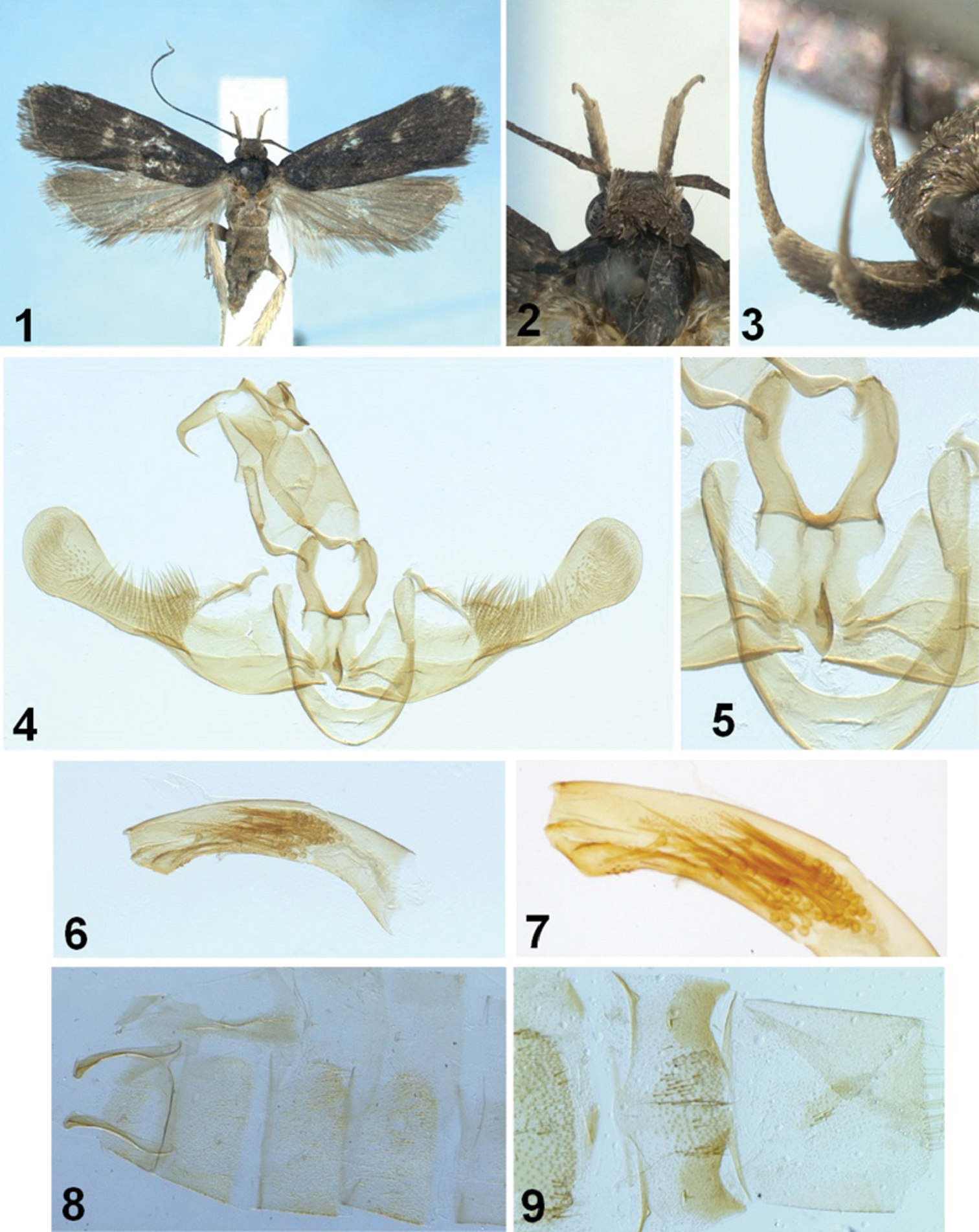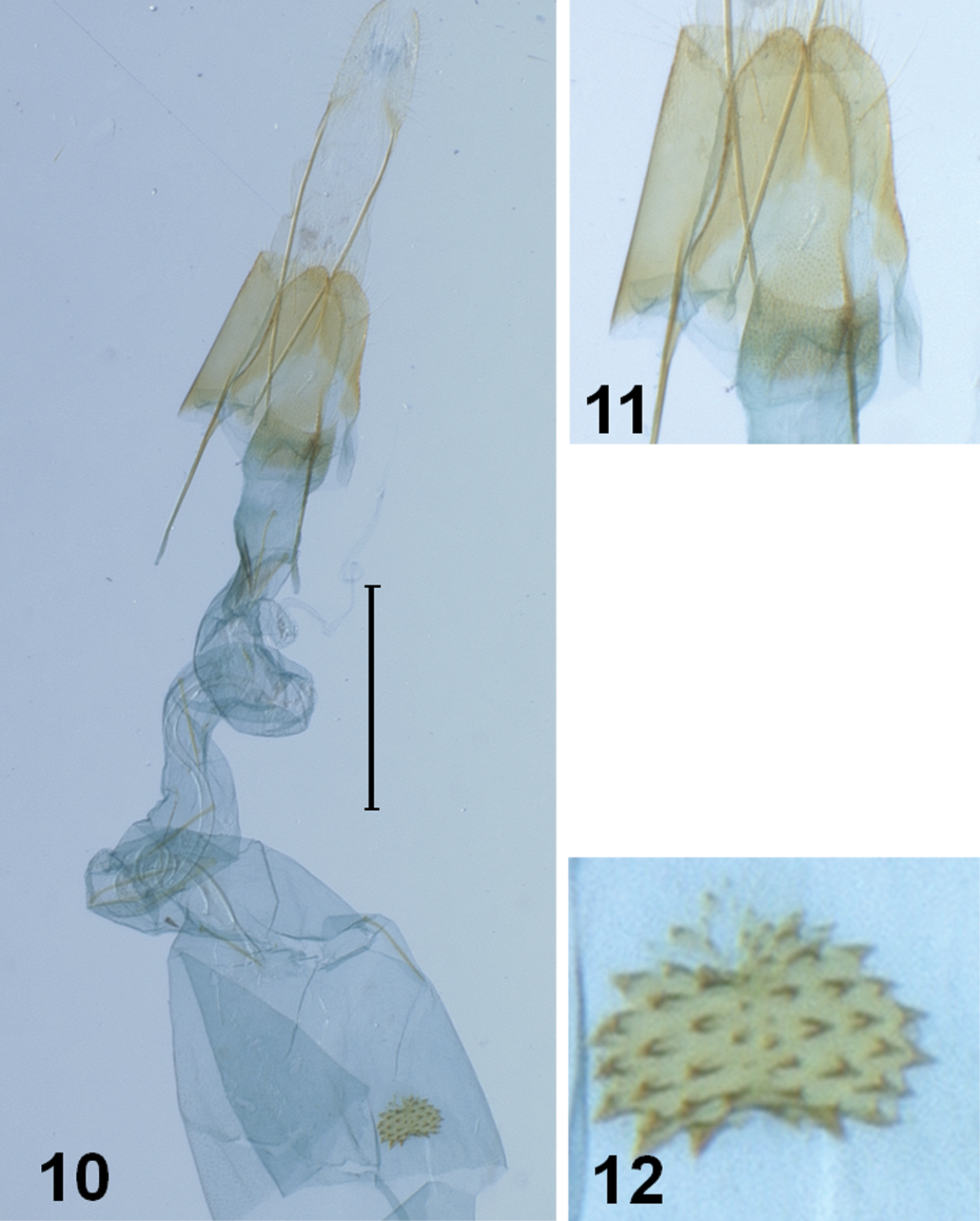






(C) 2012 Kyu-Tek Park. This is an open access article distributed under the terms of the Creative Commons Attribution License 3.0 (CC-BY), which permits unrestricted use, distribution, and reproduction in any medium, provided the original author and source are credited.
For reference, use of the paginated PDF or printed version of this article is recommended.
A new species of the genus Synersaga Gozmány, Synersaga mondulkiriensis sp. n., is described from Cambodia. The genus is diagnosed, and a global catalogue for the genus is provided.
Lepidoptera, Lecithoceridae, Synersaga, new species, Cambodia, taxonomy
The family Lecithoceridae (Lepidoptera, Gelechioidea) is characterized by the very long antenna, usually longer than the forewing, and the male genitalia with gnathos bent downwards or absent. These characters are useful to differentiate from other gelechioid-moths. With respect to Lecithoceridae biology, larvae are known to feed on dead plant materials. A few Australian species have been reported to be reared on leaf litters of eucalypt (Common 1996). Recently,
Synersaga Gozmány, 1978 is a small genus belonging to the subfamily Lecithocerinae that comprises six species only in the Oriental Region: the type species, Synersaga pseudocathara (Diakonoff, 1952) described from Myanmar, and five more species from East and Southeast Asia (
The genus is allied to Lecithocera Herrich-Schäffer, 1853 and is defined by the combination of following characters: vein R3 on the forewing is separate or connate and the male genitalia have the cucullus fairly elongated and usually expanded distally, and well- developed caudal processes of the juxta. On the other hand, for several species of Lecithocera known from Sri Lanka, which have male genitalia resembling Synersaga, e.g. Lecithocera capnaula Meyrick, 1911, Lecithocera haemylopsis (Meyrick, 1911), Lecithocera nubigena (Meyrick, 1911), Lecithocera paroena (Meyrick, 1906), and Lecithocera paroristis (Meyrick, 1911), the generic placement should be reconsidered by examining the forewing venation.
Material and methodsThe present study is based on recent material collected by the authors in Cambodia, from the result of an entomological expedition to Cambodia by the Environmental Ministry, Korea. The wingspan is measured from the left wing apex to the right wing apex, including fringe. The color standard for the description of adults follows
http://species-id.net/wiki/Synersaga
Synersaga is characterized by the forewing characters: forewing slightly broader distally with round apex, evenly colored, with yellowish brown or blackish ground color; venation with R3 free or connate with R4+5; M3 and CuA2 short-stalked or connate. However, the forewing color patterns of the known species are very similar to each other and they can be differentiated from one another by the shape of the uncus and the caudal processes of the juxta in the male genitalia. The abdominal tergites are densely spinose, and the seventh tergite is uniquely specialized, produced laterally with a sclerotized anterior margin.
World catalogue of Synersaga
Synersaga bleszynskii (Gozmány, 1978: 143) China
TL (Type locality): Chekiang, China. Type in HMNH.
Fig.:
Synersaga caradjai (Gozmány, 1978: 143) Taiwan
TL: Kosempo, Taiwan. Type in HNHM.
Fig.:
Synersaga kuni Park, 2007: 206 Vietnam
TL: Cuc Phoung, N. Vietnam. Type in KNA.
Fig.:
Synersaga mondulkiriensis sp. n. Cambodia
TL: Mondulkiri, Cambodia. Type in UIK.
Fig.: Park & Bae (2012, Figs 4–12 )
Synersaga nigriptera Park, 2007: 208 Vietnam
TL: Babe, N. Vietnam. Type in KNA.
Fig.:
Synersaga phuruaensis Park, 2009:2 Thailand
TL: Loei, China. Type in OPU.
Fig.: Park (2009, Figs 4-6, 8, 8a, 10)
Synersaga pseudocathra (Diakonoff, 1951: 76)
Ark. Zool. 1951, 3: 76. TL: Kambaiti, Myanmar. Type in NRS.
Fig.:
urn:lsid:zoobank.org:act:839DA14C-9E99-4CEC-A7A0-24E0826F8454
http://species-id.net/wiki/Synersaga_mondulkiriensis
Figs 1–12Holotype ♂ – Cambodia, Prov. Mondulkiri, Seima Biodiversity Conservation Area, 12°57'N, 107°10'E, 3–8 July 2009 (Bae & Chae), gen. slide no. CIS-6072/Park. Paratype – 3♂, 1♀, same locality, 7 Oct. 2010.
This new species is similar to Synersaga pseudocathara from Myanmar, and Synersaga kuni and Synersaga nigriptera from Vietnam in the external and male genitalic characters. It can be distinguished from them by the shape of cucullus and the caudal processes of the juxta in the male genitalia. The caudal processes of the juxta of the new species are similar to those of Synersaga nigriptera, but longer and arched inwardly, and the distal portion of the cucullus is more or less clavate.
Adult (Figures 1, 2, 3). Wingspan, 17–18 mm. Head and thorax dark fuscous dorsally. Antenna dark fuscous throughout, relatively thick. Second segment of labial palpus fairly thickened, dark fuscous on outer surface with orange white apex, orange white on inner surface; 3rd segment slender, as long as 2nd segment, orange white all around. Forewing covered with dark fuscous scales throughout; two blackish discal spots well developed: one in middle, the other larger one at end of cell; apex rounded; termen slightly concave medially; venation with R1 arising from middle of cell; R2 nearer to R3 than R1 at base; R3 free; R4 and R5 stalked for basal 3/5 length; R5 reaching just beyond apex; M3 arising from half between M2 and CuA1+2 at base; CuA1 and CuA2 stalked for basal 1/5. Hindwing broader than forewing, pale brownish orange; apex more or less obtuse; termen sinuate; fringe concolorous, with narrow orange white basal line; venation with M3 and CuA1 short stalked. Hind tibia clothed with orange gray scales.
Male genitalia (Figures 4, 5, 6, 7). Uncus broad, short, obtuse, not exceeding basal stalk of gnathos, with small median lobe on caudal margin. Median process of gnathos strongly bent beyond middle, with acute apex. Valva broad basally, with triangular process near base on costa; costa gently concave; ventral margin gently arched outward in basal half; cucullus elongate, broadly expanded with round outer margin; dense long setae in basal half of cucullus, fairly setose beyond. Juxta with caudal processes long, gently arched inward, while the processes in Synersaga nigriptera nearly straight, clavate. Aedeagus gently curved, shorter than valva+cucullus, with finely dentate along ventral and dorsal margins apically; cornuti consist of a series of numerous needle-like cornuti. Abdominal segments in Figures 8 and 9.
Female genitalia (Figures 10, 11, 12). Similar to those of Synersaga nigriptera. Caudal margin of eighth abdominal sternite with deep Y-shaped medial emargination. Dorsal surface of ostial plate with dense spinules; caudal margin of ostium bursae concave. Antrum weakly sclerotized, cup-shaped. Ductus bursae coiled twice, slightly longer than corpus bursae, nearly same width throughout, with several needle-like spines internally. Corpus bursae elongate; signum a semiovate plate denticulate throughout.
Synersaga mondulkiriensis sp. n., holotype 1 adult, holotype 2 head in dorsal view 3 labial palpus 4 male genitalia 5 close-up of juxta 6 aedeagus 7 close-up of cornuti 8 1st-4th abdominal segments 9 close-up of 6th–8th abdominal segments. Scale bar: 1 mm.
Female genitalia of Synersaga mondulkiriensis sp. n. 10 genitalia 11 8th segment 12 genitalia. Scale bar: 1 mm.
Cambodia (Mondulkiri).
The species name is derived from the type locality.
We are indebted to Prof. Woo-Shin Lee, Seoul National University, Korea; Mrs. Kry Masphal and Thuch Phalla, Wildlife Protection Office, Phnom Penh, Cambodia, for their helpful collecting management. The present study was supported in part by the National Institute of Biological Resources (NIBR), the Ministry of Environment, and the University of Incheon Research Grant (2010) in Korea. We thank Dr. James E. Hayden, Florida State Collection of Arthropods, Division of Plant Industry, FDACS, Gainesville, FL, USA, for his careful reading and corrections to the manuscript.

